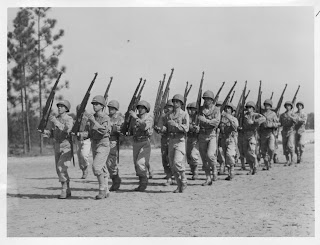Gila River Relocation Center
"All of us can't stay in the [internment] camps until the end of the war. Some of us have to go to the front. Our record on the battlefield will determine when you will return and how you will be treated. I don't know if I'll make it back."Technical Sergeant Abraham Ohama, Company "F", 442nd RCT, Killed in Action 10/20/1944
While Toguri struggled to survive in Tokyo her family in Los Angeles faced their own desperate situation. Pearl Harbor triggered an onslaught of anti-Japanese sentiment throughout the country. The majority of persons of Japanese ancestry who lived in California were industrious and loyal, but they carried the stigma of a reviled nation. On February 19th, 1942 President Roosevelt signed Executive Order 9066 authorizing the immediate relocation of suspected saboteurs and spies to "exclusion zones". On May 3, General John Dewitt, California's military commander, ordered all individuals of Japanese ancestry, whether citizens or not, rounded up and shipped to relocation camps. Dewitt explained his decision to Congress, "A Jap's a Jap. I don't want any of them here. They are a dangerous element. There is no way to determine their loyalty. It makes no difference whether he is an American citizen, he is still a Japanese. We must worry about the Japanese all the time until he is wiped off the map."
Along with 110,000 other inhabitants of Japanese ancestry who lived on the Pacific coast, the entire Toguri family - father Jun and mother Fumi, brother Fred and his wife Miyeko and Iva's sisters June and Inez were ordered to a temporary assembly center in Tulare, California. They were to await transport to a permanent relocation camp.
In her biography Tokyo Rose Orphan of the Pacific Masayo Duus described the primitive conditions of the so-called assembly centers scattered throughout the west. "Within a few weeks they [individuals of Japanese ancestry] had been herded into jerry-built wooden barracks thrown up on racetracks, fairgrounds, or live stock pavilions. The barracks were crowded, flimsy and without any privacy. Even the toilets were communal."
With hundreds of other detainees the Toguri family arrived at Tulare on May 6th, 1942. They were housed in a 10 by 20 foot horse stall. There were no windows, no fresh air. They slept on cots. Fifty-four year old Fumi, who was paralyzed on her right side from a stroke, grew weaker each day. On May 24th she died.
On September 2nd the military moved the Toguri's to the Gila River Relocation Center. Gila River a Native -American reservation was taken over by the Federal government over the objections of the Gila River Indian tribe. Located on a barren stretch of desert approximately 30 miles southeast of Phoenix the internment camp was designed to accommodate 10,000 detainees. But by December 2nd over 14,000 Japanese occupied the camp making it the 4th largest city in Arizona. By internment camp standards Gila River was one of the most humane. Residents lived in barracks specially built to ward off the desert heat. Watchtowers and barbed wire were unnecessary because no one was foolish enough to try to cross the harsh landscape on foot. The camp had playgrounds, a post office, stores, it's own police force, and sundry other small town services. All of the detainees were expected to work. Jun took a job at a supply store. Fred, who studied law, worked as a butcher. June was a seamstress and Inez worked in the mess hall.
Eleanor Roosevelt visited the Gila River Camp in 1943. She surely must have had mixed feelings about what she saw. She praised the humanitarian conditions of Gila River, but she also made it clear that she considered internment wrong.
"A Japanese American may be no more Japanese than a German-American is German, or an Italian-American is Italian, or of any other national background. All of these people, including the Japanese Americans, have men who are fighting today for the preservation of the democratic way of life and the ideas around which our nation was built.
We have no common race in this country, but we have an ideal to which all of us are loyal: we cannot progress if we look down upon any group of people amongst us because of race or religion. Every citizen in this country has a right to our basic freedoms, to justice and to equality of opportunity. We retain the right to lead our individual lives as we please, but we can only do so if we grant to others the freedoms that we wish for ourselves." Despite the fact that many of their families were interned in relocation camps over 30,000 Japanese-Americans volunteered for military service.
The 442nd Nisei Regiment fought in Italy, Germany and southern France. Because of its distinguished battle record the 442nd received eight Presidential Unit Citations. Regimental soldiers were awarded 52 Distinguished Service Medals, 588 Silver Stars and 5,200 Bronze Stars. Twenty-one members of the Regiment received the Congressional Medal of Honor for valor on the battlefield. The Regimental motto was "Go for Broke. It's nickname was the "Purple Heart Battalion". The 442nd Nisei Regiment is considered to be the most highly decorated infantry division in the history of the United States Army.
The 442nd in Training Exercise
Ohama quote: www.the442.org (Retrieved April 9, 2013)
Dewitt quote: p. 108-109, Frederick P. Close, Tokyo Rose An American Patriot
Roosevelt quote: http://www.javadc.org/gila_river_relocation_center.htm; retrieved April 9, 2013


No comments:
Post a Comment